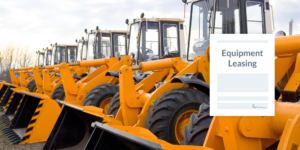
Growing a construction business often requires the use of debt or other forms of construction financing to fund large capital expenditures, particularly equipment. Whether your trade requires significant investment in tools, yellow‐iron, trucks, trailers, or the like, there is a wide range of equipment leasing and financing options available to you — but not all are created equal.
Faced with lack of equipment, company tries to sell
My firm, Whitley Penn, was recently introduced to the owners of a construction company who were looking to sell. The company had grown to several million dollars in revenue over the previous five years. The owner was approached by a private equity firm that expressed interest in purchasing the company.
After receiving a letter of intent (LOI) from the prospective buyer, the owner sat down with us to review and discuss the proposed terms.
The purchase price was based on a multiple of five times the most recent year’s earnings with an earn‐out that would pay additional funds to the company’s owners on earnings growth, albeit at a discounted value. The owners were adamant that they could double earnings over the next twelve months, and that they should receive full value for these prospective earnings — making the private equity firm’s offer insufficient in their view.
After concluding that the terms of the LOI were not agreeable, we asked him why he wanted to sell his business.
He and his business partner are both young and active with several decades of career ahead of them and they were optimistic about their ability to continue growing the business.
He plainly stated, “I’m out of options. I know we can continue to grow the business, but I can’t get the equipment I need to take on additional work.”
Convinced we could help the owners avoid selling prematurely, we advised them to turn down the LOI and shifted our focus to the equipment problem at hand.
“I know we can continue to grow the business, but I can’t get the equipment I need to take on additional work.”
The culprit: High-interest equipment leases hampering growth
When the business was just getting off the ground, the owners had no credit history and very little cash. As a result, the company was not a great candidate for traditional bank financing and options for funding equipment purchases were limited.
As we looked at the company’s existing financing arrangements, we discovered that they had entered into more than $1 million of problematic equipment leasing arrangements. Equipment leases, as distinguished from a traditional debt instrument, often do not provide a stated interest rate — instead providing just the payment amount due and the number of payments.
Analyzing these leases, we discovered that the company was paying on average nearly 30% implied annual interest on its existing leases, with one lease topping 50%.
To make matters worse, the leases had terms that prevented prepayment. No wonder they were feeling cash‐strapped and unable to fund future growth! The owners had been so consumed with putting equipment on the ground that they failed to do proper due diligence before entering into their financing agreements.
While there was no opportunity to right these past decisions, we could help the company make sure that this never happened again. The company was going to need an additional $1.5 million of equipment over the next twelve months to achieve its growth goals. The obvious answer might have been to completely avoid equipment leases in favor of more traditional financing arrangements — but this was not the case for this company.
The solution: Improve financials for favorable equipment rates & higher valuation
The company’s relative youth and lack of back‐office function prevented it from obtaining an equipment line of credit from a traditional bank. We could not help with the company’s lack of credit history, but we were able to help with the company’s back office.

Thea Dudley teaches credit & collections
Join the free certificate course to learn the foundations of credit & collections in construction with 30-year industry veteran Thea Dudley.
They had no professional accountant and needed one desperately, so instead of hiring a full‐time employee, they outsourced this function to our firm at a fraction of the cost. Doing this allowed the company to have accurately presented financial information that we could take to lenders. We were then able to connect the owners with several trusted equipment leasing groups with who we had worked previously.
They were able to finance our client’s equipment leases at interest rates below 10% with no prepayment penalties.
The company ended up obtaining financing on all $1.5 million of its equipment needs with minimal cash outlay. This funding fueled revenue growth of more than 100% over the next twelve months, and the company is now in talks with a capital partner to provide additional equity to fund future growth.
The owners expect an eight‐figure sale of the business in the next five years as they continue to pursue aggressive but healthy growth.
Learn more about financials: These 4 Financial Statements Help Contractors Hold Onto Their Cash
Financing equipment? Watch out for red flags
Accurate financial information is the primary determinant of a business’s ability to obtain favorable terms, whether from a bank or a leasing company. While leasing arrangements can be a useful tool for certain businesses, certain lenders and arrangement types should be avoided.
When entering into a leasing arrangement, business owners should look for the following red flags and ask questions:
- Prepayment penalties
- Lack of stated interest rate in the lease agreement
- Administrative and document fees
- Automatic renewal triggers
- Lump-sum “residual value” payments at the end of lease term
Funding a growing business, whether new or established, requires thoughtful consideration as carelessness can result in long‐term harm to a business or, at the very least, missed opportunities.
– Connect with Chris O’Shell, CPA/ABV, on LinkedIn.
Learn more: The Ultimate Guide to Construction Accounting